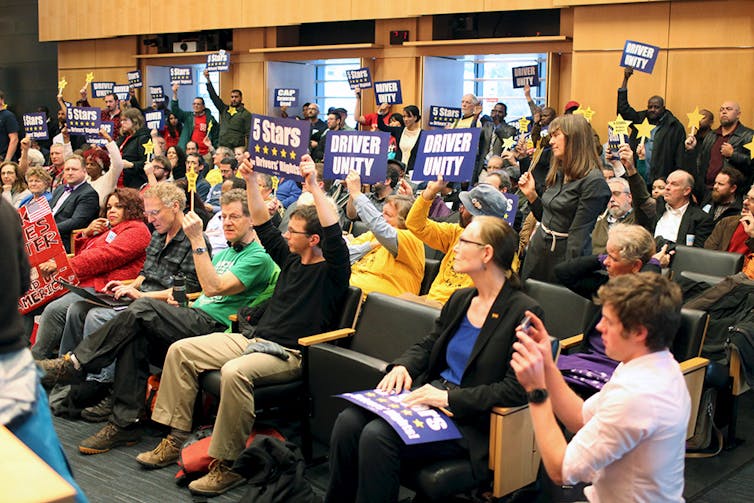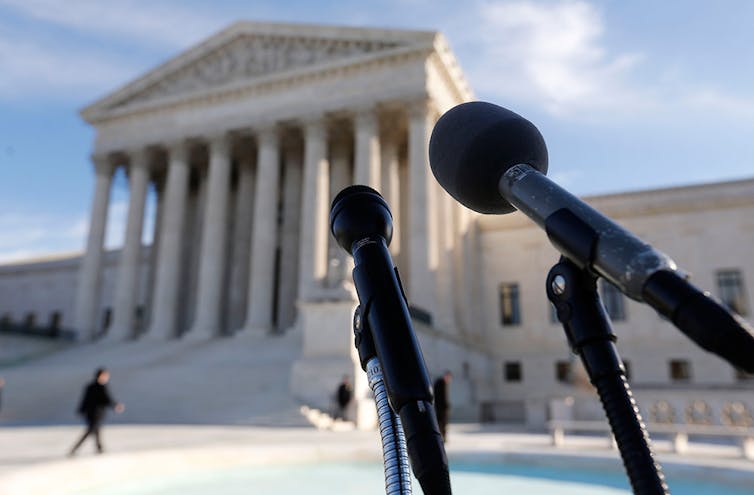The U.S. Supreme Court heard a case this week that may deal a significant blow to labor unions and shows why it’s vital, to my mind, to come up with a new social contract governing work.
The case involves 10 California teachers who argue they can’t be forced to support a public union they declined to join despite receiving the benefits gained from collective bargaining. It’s part of an ongoing conservative effort to weaken unions in the U.S.
A ruling in their favor, which appears likely, would be a setback not just for organized labor but also for conversations now under way over how to update the full range of employment policies and institutions to better match today’s world of work.
That means it’s urgent that Americans continue discussions like those held last month at a gathering of leaders from business, labor and elsewhere to discuss the future of work. At the meeting, Secretary of Labor Tom Perez challenged attendees to negotiate a new social contract governing labor, which he called Social Compact 2.0.

What happened to social compact 1.0?
The secretary’s use of the 2.0 tagline reflected the fact that the U.S. once had a viable social contract or compact, which lasted from about the end of World War II up to 1980.
Labor legislation passed in the New Deal (minimum wages and overtime protections, social security, unemployment insurance and the right to unionize) provided the foundation for that social contract, and collective bargaining made it work by negotiating wage increases in tandem with productivity growth.
But at least in part because those policies and practices could not cope well with developments since 1980 – such as globalization and corporate short-termism – the country has experienced three decades of wage stagnation, rising income inequality and the erosion of the social safety net that was designed to ensure basic protections and minimum employment standards.
Restoring such a safety net, which would be further eroded if the Supreme Court rules against the unions, will require broadening the circle of debate to engage the powerful interest groups that don’t necessarily share the view that changes are needed.
Given the hopeless gridlock in Congress on labor policy issues, the best path forward might be to focus on private sector leaders and those on the front lines of innovations that might just help identify the features of a new social compact.
I’ve argued in my own work that national leadership on this front is long overdue, and I’m delighted to see the attention and passion Secretary Perez is giving this issue.
Here are three high-priority ideas highlighted by participants at his gathering that can help us reach a new compact and deserve broader discussion.
How to wean social benefits from employment
A major point of debate at the meeting was whether or not the economy, business and workforce would all be better off if we could sever the safety net from employers. That is, should we separate the funding and coverage for benefits such as health insurance, retirement savings and sick and family leave from individual employment relationships?
President Barack Obama highlighted this idea in his last State of the Union address, arguing such “basic benefits should be as mobile as everything else is today.”
The U.S. chose to link health care and pension benefits to employers during and after World War II in an era when the image of the employment relationship was of an individual (mostly male) working full-time for a large company for an extended period of time, and perhaps a full career with a wife at home taking care of family and community responsibilities.
Obviously those conditions no longer capture today’s workforce diversity, work-family responsibilities, tenure and mobility patterns or the variety of full time-part-time, contractor, franchise or temporary work settings.
How to separate benefits from employment status will be difficult, but it should not be impossible.
My own private conversations with human resource professionals from some of America’s largest companies suggest their organizations want to get out of the health care and retirement security business entirely.
How can we do this in ways that enhance health care and retirement security rather than simply leave the workforce to fend for itself?
A new way to regulate and enforce standards
Another area of discussion was how to modernize regulation and enforcement of employment standards.
The Department of Labor’s wage and hour administrator, David Weil, put this issue on the table in early 2014 in a paper discussing what he has labeled the “fissured” workplace. In other words, the growth of alternative forms of work – such as contractors, temporary staff and on-demand employees – has left many workers outside the standard safety net of minimum wages, overtime and other New Deal-era employment policies.
The good news is the rise of Uber and other on-demand platforms has put this issue front and center in the national media and is generating new policy proposals to fix it.
And in Seattle and California, it is generating efforts to extend collective bargaining and coverage of basic employment standards to Uber drivers.
It is important to let these efforts play out and evaluate their effects. Will drivers actually mobilize and negotiate, or are they as happy with their individual arrangements as Uber believes? Will treating drivers as employees rather than contractors ruin Uber’s business model or lead to further innovations that keep the new platforms growing while providing a more fair distribution of the profits to drivers?
My prediction, based on the historical evidence from when collective bargaining first became a powerful force in American industry, is that these new businesses will adapt and further innovate in ways that allow them to continue to grow, prosper and share their prosperity with those who do their work.

Breaking the chains of our ossified labor law
Unlike the debate at the Supreme Court, participants in this meeting focused on how to rebuild bargaining power so workers have an effective voice in shaping the future of work. There was a crucial breakthrough over this issue.
In the past this issue was framed narrowly as a zero-sum game over whether or not to strengthen or reform existing rules governing union organizing and collective bargaining. This approach has consistently failed to break the business-labor gridlock over our ossified labor policy and is not likely to be any more successful in the future.
Many at the meeting called for new approaches, reflecting developments emerging across the country, some of which go well beyond the procedures and doctrines enshrined in our 1935 National Labor Relations Act.
Consider, for example, the fight for a US$15 minimum wage that is going on in a wide variety of “negotiations” involving community groups, unions, local governments and businesses without any formal legally protected structure or process. Worker centers, often allied with religious and immigrant coalitions, are mobilizing to enact living wage ordinances and community benefit agreements in cities across the country.
Other visible examples of groups without formal bargaining powers negotiating for better treatment include the Freelancers Union, Restaurant Opportunities Centers, the Taxi Workers Alliance and the Domestic Workers Alliance.
“Letting a thousand flowers bloom” makes good sense, but we should also ask the tough question that labor leader David Rolf keeps posing: are these efforts sustainable, will they grow from isolated examples to a scale big enough make a national difference and are they able to replace the bargaining power for workers that collective bargaining provided under the old social contract?

From ideology to evidence-based
Now is the time to go beyond speaking to the choir and engage the broader stakeholders in business, labor and government who are not yet convinced of the need for fundamental, forward-looking changes in workplace policies and labor market institutions.
But this will work only if we replace ideologically driven attacks against unions – like those before the Supreme Court this week – with hard evidence. That evidence can be gained from tracking the many local experiments under way to build on and improve what workers, unions, employers and government leaders are doing to shape the workplace of the future in ways that work better for all.
By doing so, we might just identify the features of a Social Compact 2.0 a majority of Americans can support and take to a national level – if and when the political stars align to make this possible.

